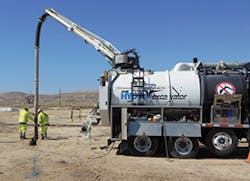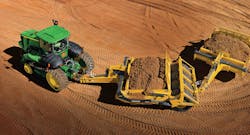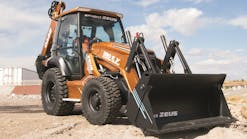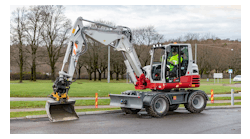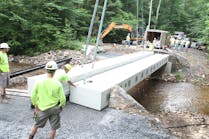This article first appeared in the May 2014 issue of Grading & Excavation Contractor.
In this expository series that combines vacuum excavation applications and utility locator technologies, author Carol Brzozowski discusses the site specific conditions that help determine the choice between hydro versus air vacuum excavation. Follow this series below as such conditions as frozen soil and brittle utilities are evaluated in determining vacuum excavation methods and why nothing beats an experienced operator and reliable equipment.
Hitting the Hidden Mark (Part 7) By Carol Brzozowski
The combination of the vacuum and utility locator help get that precise target.
In a continuing discussion combining vacuum excavator work and utility locator technologies, author Carol Brzozowski discusses the applications of cable and pipe-locating equipment. As this series continues, soil-type factors and environmental conditions continue to present challenges in utility location and identification. Learn how utility locator manufacturers are addressing these potential instrument limitations in the segment below.
This article first appeared in the May 2014 issue of Grading & Excavation Contractor. In this expository series that combines vacuum excavation applications and utility locator technologies, author Carol Brzozowski discusses the site specific conditions that help determine the choice between hydro versus air vacuum excavation. Follow this series below as such conditions as frozen soil and brittle utilities are evaluated in determining vacuum excavation methods and why nothing beats an experienced operator and reliable equipment.Hitting the Hidden Mark (Part 7) By Carol Brzozowski
The combination of the vacuum and utility locator help get that precise target. In a continuing discussion combining vacuum excavator work and utility locator technologies, author Carol Brzozowski discusses the applications of cable and pipe-locating equipment. As this series continues, soil-type factors and environmental conditions continue to present challenges in utility location and identification. Learn how utility locator manufacturers are addressing these potential instrument limitations in the segment below. [text_ad] Rycom Instruments makes cabling and pipe locating equipment designed to identify the approximate location of a buried facility. The equipment induces a signal on the utility. Using an electronic receiver, its operator uses the signal to pick up a target. “In the start of our manual and in every cabling and pipe location equipment manual is a simple statement that the only way to know the exact location or depth of the utility is to dig it up and expose it,” says Doug Reitz, vice president of operations and Midwest sales for Rycom Instruments. “That’s where the daylighting technology goes hand in hand with the locating technology. “There is locating that’s done every day, and often people are working fairly close to that utility. It is in everyone’s best interest to use a cable locator in the beginning, identify where the line is, and then if you’re working near that line to use a vacuum excavator, expose it, and verify that it is actually the line you were thinking you were locating and that it is the set depth the locator told you it was at. Then you clearly know there was a utility there.” Reitz contends there are “many myths and much folklore” about certain electronic locating units working better in certain environments. “A drier soil environment makes it more difficult just to get a signal on the line, because you’re creating an electrical circuit,” says Reitz. “The drier soil conditions make it more difficult, but really there’s no reason other than superior manufacturing, engineering, and design makes one unit better in an environment or a soil condition than another unit.” Rather, it’s a function of user’s power output and frequency, he adds. “That gives them the best tools in the field to overcome variance in soil conditions and congested areas where there are a lot of other cables within the same area that could cause interference,” says Reitz. “When it comes to the vacuum excavation equipment, there is a lot of thought process between clay soil and sandy soil and rock—what works best is to break it up and move it,” he adds. “On our side, soil either interferes, or if there’s iron in the soil, it’s going to interfere with the system more.” [text_ad] If there’s sand or rock, it makes the task more difficult to get the circuit going, but once the signal is applied to the line, it does not matter what soil is above it, Reitz says. The two units Rycom manufacturers for this type of work are the 8879 and 8869. Reitz notes that the 8869 is a “jack of all trades” and costs $1,000 less than the 8879. The 8869v3 Pathfinder Locating System includes FrequencyFlex, which allows users to adapt the system to their specific needs. Multiple active frequencies allow users to accurately locate with a minimum of “ghosting” to adjacent lines, while maintaining the ability to continue locating past faults and poor utility conductors. Passive frequencies—50 Hz, 60 Hz, radio frequency, cathodic protection rectifier, and CATV—identify “live” lines by their naturally occurring electromagnetic fields, allowing line locating without the use of a transmitter. Transmitter functions include improved transmitter induction and automatic impedance matching when using direct connection. All functions are accessed via weatherproof membrane buttons. User input and transmitter status are verified with audible responses. Signal application methods include direct connection, induction mode, and coupler induction. The receiver provides instant push-button depth up to 25 feet and current measurement to identify the target utility in crowded easements. Audible proximity cues to the tracing signal are given to the user through either peak or null tones while the backlit digital display provides both relative and actual signal strength. The 8869v3 can quickly and simply locate line faults when used with the optional A-frame ground return probe. As the operator moves towards the fault, the receiver responds with a rapidly peaking signal. When the A-frame is placed directly over the fault, the receiver will provide a null response. Conduit pinches can be located using the optional Sonde accessory operating on active frequencies of 512 Hz, 640 Hz, 815 Hz, 8 kHz, and 33 kHz. Rycom Instruments Sondes are pushed into nonpressurized conduits and pipes until they reach the point of pinch or blockage. Traceable 25 feet in the air and 10 feet in cast iron, the 8869-RF receiver is designed to identify the precise location of the line blockage. The Rycom 8879v3 cable and pipe locator also offers utility locators FrequencyFlex, enabling them to adapt the system to their specific needs. Multiple active frequencies are designed to allow the user to accurately locate with a minimum of interference while maintaining the ability to continue locating past faults and around conduit bends. Updated transmitter functions include improved transmitter induction, multifrequency coupled induction ranging from 8 kHz to 118 kHz, and automatic impedance matching for direct connections. The 5-W or 10-W transmitter has the ability to simultaneously apply two frequencies to a utility. From one transmitter setting, the user can locate the main line as well as other services by “lighting up” the entire site. The set-and-forget feature is designed to save time and money by reducing the need to repeatedly relocate the transmitter. The 8879v3 receiver provides instant push-button depth up to 25 feet and current measurement to help identify target utilities in crowded easements. Proximity cues to the tracing signal are given to the user through either peak or null tone modes while the backlit digital display provides both relative and actual signal strength. The 8879v3 is designed to quickly and simply locate lines with faults when used with the optional A-frame ground return probe. Conduit pinches can be located using the optional Sondes. “If you’re going to bore under a pipe, and your cable locator says that pipe is 4 feet deep, and you think you can go 6 feet deep and bore right under it, until you daylight it, there is no real way to identify the exact depth,” says Reitz. “You can be a foot-and-a-half off, and then you end up boring right through the pipe. “The technology isn’t perfect on the cable-locating side for depth to give you an exact depth reading,” he adds. “For that, it’s strongly recommended in the front of everyone’s manual that you expose the line before you dig near it.” In the next part of this series—a continuation of utility locators and vacuum excavation applications—author Brzozowski specifically discusses specific site conditions that decide vacuum excavator selection and methods.Rycom Instruments makes cabling and pipe locating equipment designed to identify the approximate location of a buried facility.
The equipment induces a signal on the utility. Using an electronic receiver, its operator uses the signal to pick up a target.
“In the start of our manual and in every cabling and pipe location equipment manual is a simple statement that the only way to know the exact location or depth of the utility is to dig it up and expose it,” says Doug Reitz, vice president of operations and Midwest sales for Rycom Instruments. “That’s where the daylighting technology goes hand in hand with the locating technology.
“There is locating that’s done every day, and often people are working fairly close to that utility. It is in everyone’s best interest to use a cable locator in the beginning, identify where the line is, and then if you’re working near that line to use a vacuum excavator, expose it, and verify that it is actually the line you were thinking you were locating and that it is the set depth the locator told you it was at. Then you clearly know there was a utility there.”
Reitz contends there are “many myths and much folklore” about certain electronic locating units working better in certain environments.
“A drier soil environment makes it more difficult just to get a signal on the line, because you’re creating an electrical circuit,” says Reitz. “The drier soil conditions make it more difficult, but really there’s no reason other than superior manufacturing, engineering, and design makes one unit better in an environment or a soil condition than another unit.”
Rather, it’s a function of user’s power output and frequency, he adds.
“That gives them the best tools in the field to overcome variance in soil conditions and congested areas where there are a lot of other cables within the same area that could cause interference,” says Reitz.
“When it comes to the vacuum excavation equipment, there is a lot of thought process between clay soil and sandy soil and rock—what works best is to break it up and move it,” he adds. “On our side, soil either interferes, or if there’s iron in the soil, it’s going to interfere with the system more.”
This article first appeared in the May 2014 issue of Grading & Excavation Contractor. In this expository series that combines vacuum excavation applications and utility locator technologies, author Carol Brzozowski discusses the site specific conditions that help determine the choice between hydro versus air vacuum excavation. Follow this series below as such conditions as frozen soil and brittle utilities are evaluated in determining vacuum excavation methods and why nothing beats an experienced operator and reliable equipment.Hitting the Hidden Mark (Part 7) By Carol Brzozowski
The combination of the vacuum and utility locator help get that precise target. In a continuing discussion combining vacuum excavator work and utility locator technologies, author Carol Brzozowski discusses the applications of cable and pipe-locating equipment. As this series continues, soil-type factors and environmental conditions continue to present challenges in utility location and identification. Learn how utility locator manufacturers are addressing these potential instrument limitations in the segment below. [text_ad] Rycom Instruments makes cabling and pipe locating equipment designed to identify the approximate location of a buried facility. The equipment induces a signal on the utility. Using an electronic receiver, its operator uses the signal to pick up a target. “In the start of our manual and in every cabling and pipe location equipment manual is a simple statement that the only way to know the exact location or depth of the utility is to dig it up and expose it,” says Doug Reitz, vice president of operations and Midwest sales for Rycom Instruments. “That’s where the daylighting technology goes hand in hand with the locating technology. “There is locating that’s done every day, and often people are working fairly close to that utility. It is in everyone’s best interest to use a cable locator in the beginning, identify where the line is, and then if you’re working near that line to use a vacuum excavator, expose it, and verify that it is actually the line you were thinking you were locating and that it is the set depth the locator told you it was at. Then you clearly know there was a utility there.” Reitz contends there are “many myths and much folklore” about certain electronic locating units working better in certain environments. “A drier soil environment makes it more difficult just to get a signal on the line, because you’re creating an electrical circuit,” says Reitz. “The drier soil conditions make it more difficult, but really there’s no reason other than superior manufacturing, engineering, and design makes one unit better in an environment or a soil condition than another unit.” Rather, it’s a function of user’s power output and frequency, he adds. “That gives them the best tools in the field to overcome variance in soil conditions and congested areas where there are a lot of other cables within the same area that could cause interference,” says Reitz. “When it comes to the vacuum excavation equipment, there is a lot of thought process between clay soil and sandy soil and rock—what works best is to break it up and move it,” he adds. “On our side, soil either interferes, or if there’s iron in the soil, it’s going to interfere with the system more.” [text_ad] If there’s sand or rock, it makes the task more difficult to get the circuit going, but once the signal is applied to the line, it does not matter what soil is above it, Reitz says. The two units Rycom manufacturers for this type of work are the 8879 and 8869. Reitz notes that the 8869 is a “jack of all trades” and costs $1,000 less than the 8879. The 8869v3 Pathfinder Locating System includes FrequencyFlex, which allows users to adapt the system to their specific needs. Multiple active frequencies allow users to accurately locate with a minimum of “ghosting” to adjacent lines, while maintaining the ability to continue locating past faults and poor utility conductors. Passive frequencies—50 Hz, 60 Hz, radio frequency, cathodic protection rectifier, and CATV—identify “live” lines by their naturally occurring electromagnetic fields, allowing line locating without the use of a transmitter. Transmitter functions include improved transmitter induction and automatic impedance matching when using direct connection. All functions are accessed via weatherproof membrane buttons. User input and transmitter status are verified with audible responses. Signal application methods include direct connection, induction mode, and coupler induction. The receiver provides instant push-button depth up to 25 feet and current measurement to identify the target utility in crowded easements. Audible proximity cues to the tracing signal are given to the user through either peak or null tones while the backlit digital display provides both relative and actual signal strength. The 8869v3 can quickly and simply locate line faults when used with the optional A-frame ground return probe. As the operator moves towards the fault, the receiver responds with a rapidly peaking signal. When the A-frame is placed directly over the fault, the receiver will provide a null response. Conduit pinches can be located using the optional Sonde accessory operating on active frequencies of 512 Hz, 640 Hz, 815 Hz, 8 kHz, and 33 kHz. Rycom Instruments Sondes are pushed into nonpressurized conduits and pipes until they reach the point of pinch or blockage. Traceable 25 feet in the air and 10 feet in cast iron, the 8869-RF receiver is designed to identify the precise location of the line blockage. The Rycom 8879v3 cable and pipe locator also offers utility locators FrequencyFlex, enabling them to adapt the system to their specific needs. Multiple active frequencies are designed to allow the user to accurately locate with a minimum of interference while maintaining the ability to continue locating past faults and around conduit bends. Updated transmitter functions include improved transmitter induction, multifrequency coupled induction ranging from 8 kHz to 118 kHz, and automatic impedance matching for direct connections. The 5-W or 10-W transmitter has the ability to simultaneously apply two frequencies to a utility. From one transmitter setting, the user can locate the main line as well as other services by “lighting up” the entire site. The set-and-forget feature is designed to save time and money by reducing the need to repeatedly relocate the transmitter. The 8879v3 receiver provides instant push-button depth up to 25 feet and current measurement to help identify target utilities in crowded easements. Proximity cues to the tracing signal are given to the user through either peak or null tone modes while the backlit digital display provides both relative and actual signal strength. The 8879v3 is designed to quickly and simply locate lines with faults when used with the optional A-frame ground return probe. Conduit pinches can be located using the optional Sondes. “If you’re going to bore under a pipe, and your cable locator says that pipe is 4 feet deep, and you think you can go 6 feet deep and bore right under it, until you daylight it, there is no real way to identify the exact depth,” says Reitz. “You can be a foot-and-a-half off, and then you end up boring right through the pipe. “The technology isn’t perfect on the cable-locating side for depth to give you an exact depth reading,” he adds. “For that, it’s strongly recommended in the front of everyone’s manual that you expose the line before you dig near it.” In the next part of this series—a continuation of utility locators and vacuum excavation applications—author Brzozowski specifically discusses specific site conditions that decide vacuum excavator selection and methods.If there’s sand or rock, it makes the task more difficult to get the circuit going, but once the signal is applied to the line, it does not matter what soil is above it, Reitz says.
The two units Rycom manufacturers for this type of work are the 8879 and 8869. Reitz notes that the 8869 is a “jack of all trades” and costs $1,000 less than the 8879.
The 8869v3 Pathfinder Locating System includes FrequencyFlex, which allows users to adapt the system to their specific needs. Multiple active frequencies allow users to accurately locate with a minimum of “ghosting” to adjacent lines, while maintaining the ability to continue locating past faults and poor utility conductors.
Passive frequencies—50 Hz, 60 Hz, radio frequency, cathodic protection rectifier, and CATV—identify “live” lines by their naturally occurring electromagnetic fields, allowing line locating without the use of a transmitter.
Transmitter functions include improved transmitter induction and automatic impedance matching when using direct connection.
All functions are accessed via weatherproof membrane buttons. User input and transmitter status are verified with audible responses. Signal application methods include direct connection, induction mode, and coupler induction.
The receiver provides instant push-button depth up to 25 feet and current measurement to identify the target utility in crowded easements.
Audible proximity cues to the tracing signal are given to the user through either peak or null tones while the backlit digital display provides both relative and actual signal strength.
The 8869v3 can quickly and simply locate line faults when used with the optional A-frame ground return probe. As the operator moves towards the fault, the receiver responds with a rapidly peaking signal. When the A-frame is placed directly over the fault, the receiver will provide a null response.
Conduit pinches can be located using the optional Sonde accessory operating on active frequencies of 512 Hz, 640 Hz, 815 Hz, 8 kHz, and 33 kHz.
Rycom Instruments Sondes are pushed into nonpressurized conduits and pipes until they reach the point of pinch or blockage. Traceable 25 feet in the air and 10 feet in cast iron, the 8869-RF receiver is designed to identify the precise location of the line blockage.
The Rycom 8879v3 cable and pipe locator also offers utility locators FrequencyFlex, enabling them to adapt the system to their specific needs. Multiple active frequencies are designed to allow the user to accurately locate with a minimum of interference while maintaining the ability to continue locating past faults and around conduit bends.
Updated transmitter functions include improved transmitter induction, multifrequency coupled induction ranging from 8 kHz to 118 kHz, and automatic impedance matching for direct connections.
The 5-W or 10-W transmitter has the ability to simultaneously apply two frequencies to a utility. From one transmitter setting, the user can locate the main line as well as other services by “lighting up” the entire site.
The set-and-forget feature is designed to save time and money by reducing the need to repeatedly relocate the transmitter.
The 8879v3 receiver provides instant push-button depth up to 25 feet and current measurement to help identify target utilities in crowded easements. Proximity cues to the tracing signal are given to the user through either peak or null tone modes while the backlit digital display provides both relative and actual signal strength. The 8879v3 is designed to quickly and simply locate lines with faults when used with the optional A-frame ground return probe. Conduit pinches can be located using the optional Sondes.
“If you’re going to bore under a pipe, and your cable locator says that pipe is 4 feet deep, and you think you can go 6 feet deep and bore right under it, until you daylight it, there is no real way to identify the exact depth,” says Reitz. “You can be a foot-and-a-half off, and then you end up boring right through the pipe.
“The technology isn’t perfect on the cable-locating side for depth to give you an exact depth reading,” he adds. “For that, it’s strongly recommended in the front of everyone’s manual that you expose the line before you dig near it.”
In the next part of this series—a continuation of utility locators and vacuum excavation applications—author Brzozowski specifically discusses specific site conditions that decide vacuum excavator selection and methods.